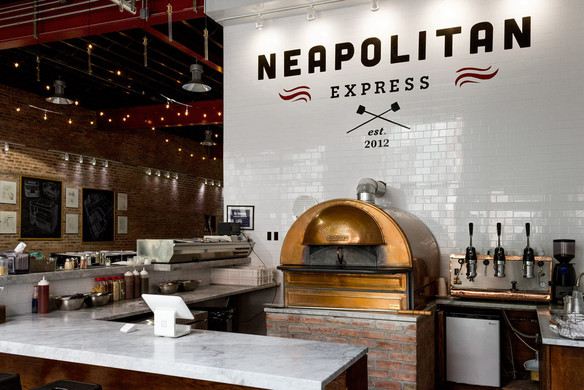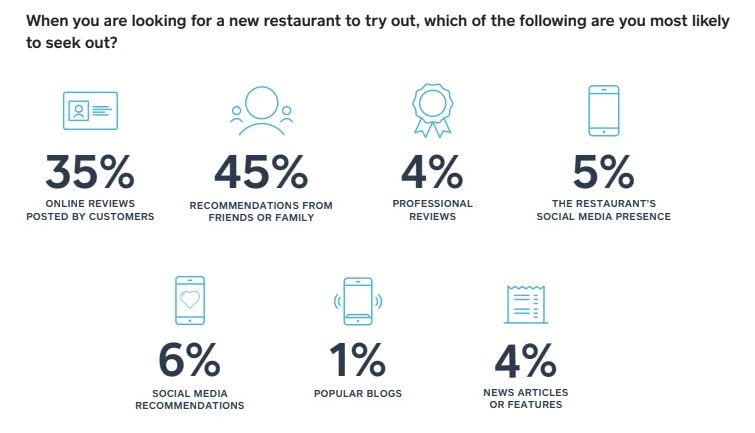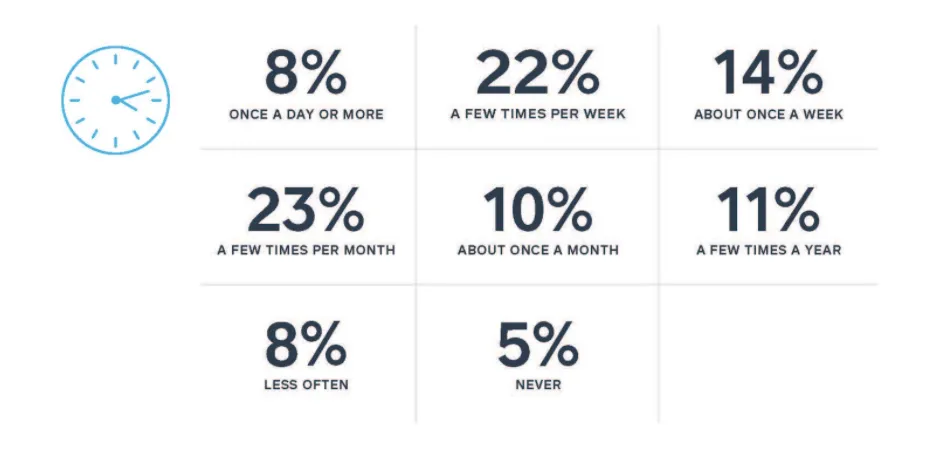From takeout lunches to white-tablecloth dinners, eating out is big business. In the past decade, spending on bars and restaurants has grown twice as fast as other retail spending in the U.S. In 2015, food and drink sales were worth $745.61 billion.
And that growth means a crowded market and lots of competition. People have almost endless options for where to dine, so to thrive you need to do all that you can to make your business stand out.
But to do that, you first need to know how people discover restaurants. So we surveyed 1,800 U.S. consumers to learn just that. (We also asked consumers why they would decide to try a restaurant and then recommend it to their friends.)
Here’s what we found:
Personal recommendations and online reviews rule.
When it comes to trying a new restaurant, nearly half of respondents said they are most likely to ask friends and family for a recommendation.
The second-most preferred method of finding a restaurant is through an online review posted by customers. Interestingly, nearly half of the people surveyed say they trust other customers’ reviews more than they trust reviews written by professionals.
The content of those reviews is important, too. Seventy-seven percent of people said it’s very or extremely important that a reliable review include specific details about the food someone purchased.
Reviews aren’t from where you’d think.
The biggest group of consumers (28 percent) say that Google Reviews is their favorite source for online reviews.
Google Reviews is built into the online discovery process, which could explain this preference. Whenever consumers perform a search on Google, they see Google Reviews. If a consumer searches “best Italian restaurant” on Google, for example, the first thing that comes up at the top of the results page is a list of local restaurants with star ratings from customers.
After Google Reviews, the next favorite online review sites are Facebook and Yelp. And consumers are checking these online platforms regularly for recommendations — over 20 percent reported looking up reviews on a website or app a few times per week, while almost a quarter reported checking a few times per month.
How often do consumers look up reviews on a website or app?
Facebook is the favorite social media platform for finding restaurants.
Seventy-eight percent of consumers said Facebook is their favorite social platform to find restaurants. Far behind Facebook are Instagram and Twitter.
Consumers aren’t just scrolling through social media and coming across restaurants. Some are proactively asking their networks for recommendations (Facebook even has a special feature for this now). Over a third of people have posted to social media to ask for a restaurant recommendation.
Now that you know how people are discovering restaurants, you’re ready to put together a plan to make your business more discoverable. Here are some tactics to ensure new customers keep coming through the door.
Ramp up online reviews.
Consumers trust their peers, so online reviews are important to draw in new customers. The more reviews available, the more information that potential clients have about your business and the food and drink you offer.
To ensure a strong presence, stay active on review sites. Respond to reviews, whether they’re positive or negative. It’s important to let customers know that they are heard and that you genuinely appreciate them taking the time to sing your praises or show you how to improve.
Learn more about how to harness the power of customer reviews with this webinar we hosted with Yelp.
Have a solid social media presence.
Building your brand on social media is an important aspect of marketing, especially when it comes to showcasing food and drink. Create a strong presence online, and ensure that you (and/or your employees) update it regularly.
To help you get started, you can find advice for building your brand on social media from Square’s expert here, learn our favorite Instagram tips for restaurants, and discover how to get creative with Stories and live video.
Optimize for SEO.
You may not be able to pick up your restaurant and move it, but knowing that location is important to potential customers means you should make sure you come up in local searches.
Doing a bit of local search engine optimization (SEO) will make sure you come up in online searches, and it doesn’t need to be complicated or involve spending thousands of dollars on an SEO agency. One easy way to start is to make sure you mention where your restaurant is on your website, as well as in your titles and meta tags (a simple plugin like Yoast can help you with this).
And if you haven’t already done so, make sure to claim your restaurant on Google My Business, which acts like a huge directory. There are lots of other directories and online listings you should sign up with, too, like Yelp, Bing, Foursquare, and local.com.
Request feedback.
How are you doing? When customers know that you take their feedback seriously, they know you care. Set out written feedback cards, or adopt a POS that requests feedback from your customers. You might also ask your employees to informally let you know of any feedback that customers have.
Why is this a tactic that spurs discovery? Well, the happier your customers are, and the more responsive you are to feedback, the more likely you are to have customers be your brand evangelist to their friends and family.
![]()














